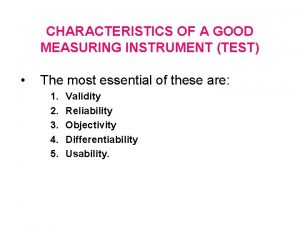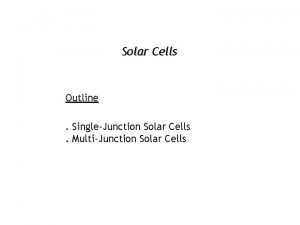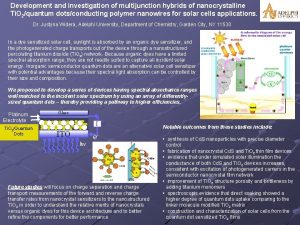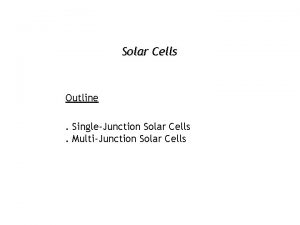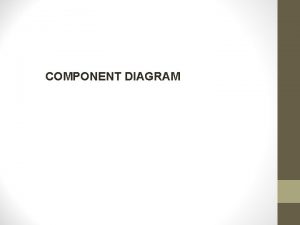Measurement of Component Cell IV Characteristics in Multijunction












- Slides: 12

Measurement of Component Cell IV Characteristics in Multijunction Solar Cells Aarohi Vijh Midwest Optelectronics LLC Chandan Das and Xunming Deng University of Toledo NREL a-Si Meeting San Francisco, April 17, 2006

Objectives Ø To obtain IV characteristics of individual component cells in tandem and triple junction solar cell stacks Ø To build instrumentation to automate this process

Procedure developed at UT (Tandem Cells) Ø Get Voc-Isc relationships for top and bottom cells Ø Measure Iscs under illumination of interest Ø Obtain Voc values from Voc-Isc relations Ø Scan IV of tandem cell under illumination of interest with top and bottom cells limiting Ø Subtract Voc of other cell (shift the IV curve) to the left

Obtaining Voc-Isc (Tandem) Ø With a blue probe light ON, measure Voc Ø Add a stronger red bias light, measure Isc Ø Turn red bias off, step up blue probe, repeat Ø Gives Voc-Isc for top cell (Tandem Cell) Top Cell Voc-Isc Bottom Cell Voc-Isc

Obtaining Cell VOCs and IV curves Ø Measure Iscs at given illumination, get corresponding VOCs Ø Reduce red light slightly, measure top-cell limited IV, shift to the left by an amount equal to VOC (bot) (Top) (Bottom)

Response of Tandem Cell Different Cell, Expected Voc=1. 4 V, Voc(bot)=0. 4 V, Voc(top)=1. 0 V Blue light: 400 nm from monochromator Red light: 800 nm longpass filtered incandescent light Red ON Red OFF Blue ON Blue OFF VOC=0. 952 V VOC=0. 940 V ISC=1. 78 m. A ISC=1. 5 m. A VOC=0. 354 V VOC=0. 040 V ISC=22. 6 n. A ISC=-150 p. A

Response of Tandem Cell Blue ON Blue light: 400 nm from monochromator Red ON Red light: 940 nm IR LED Red OFF 800 nm/940 nm fluxes were comparable Blue OFF VOC=0. 768 V VOC=0. 660 V ISC=262 n. A ISC=44. 9 n. A VOC=0. 355 V VOC=0. 010 V ISC=23. 5 n. A ISC=-170 p. A

Test setup with LED optical bias Device under test PMD 1208 -LS Keithley 2400/ HP 4140 B 940 nm LED 400 nm LED Light-tight, Shielded Enclosure

Bottom Cell IV with New System Isc=1. 24 m. A Voc=0. 55 V Voc = 0. 39 V Isc = 1. 24 m. A FF = 49. 5%

Top Cell IV

Status Ø Have applied UT method for component cell IV determination in tandem cells Ø Have assembled a computerized system for applying biases and acquiring data Ø Trying to improve the determination of Vocs in a tandem cell

Plan Ø Use filters with LEDs to eliminate any tails, or better, use lasers Ø Move further into IR for bottom cell probe light to reduce top cell response Ø Instead of a fixed bias light intensity, use one that tracks the expected Isc of the probed cell Ø If Voc-Isc relationship is accurately obtained for one cell, use that information to correct the Voc estimate for the other cell(s) Ø Test procedure for higher intensities Ø Test procedure for triple-junction cells
 Characteristics of good measuring instrument
Characteristics of good measuring instrument Golgi body school analogy
Golgi body school analogy Denuding tower
Denuding tower Prokaryotic vs eukaryotic cell
Prokaryotic vs eukaryotic cell Prokaryotic and eukaryotic cells
Prokaryotic and eukaryotic cells Plant vs animal cells
Plant vs animal cells Cell reaction
Cell reaction Dry cell vs wet cell
Dry cell vs wet cell Animal cell venn diagram
Animal cell venn diagram Cell wall function
Cell wall function Plant cell and animal cell diagram
Plant cell and animal cell diagram What is the structure and function of the smooth er?
What is the structure and function of the smooth er? Cell wall cell membrane
Cell wall cell membrane
